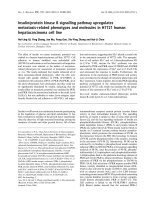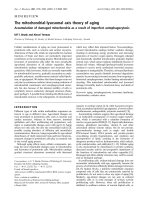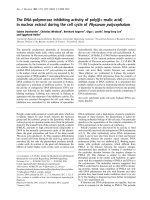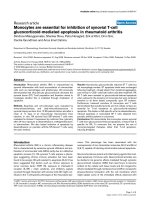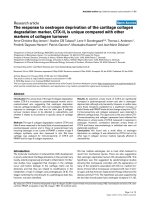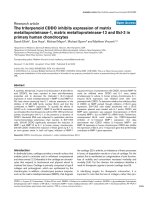Báo cáo y học: "The triterpenoid CDDO inhibits expression of matrix metalloproteinase-1, matrix metalloproteinase-13 and Bcl-3 in primary human chondrocytes" ppt
Bạn đang xem bản rút gọn của tài liệu. Xem và tải ngay bản đầy đủ của tài liệu tại đây (372.64 KB, 7 trang )
Introduction
In diarthodial joints, cartilage provides a smooth surface that
enables joints to articulate and to withstand compressional
and shear stress [1]. Embedded in the cartilage are chondro-
cytes that respond to biochemical and physical stimuli to
maintain this tissue. Cartilage is primarily composed of type II
collagen and proteoglycan, which are synthesized by the
chondrocytes. In addition, chondrocytes produce enzymes,
such as the matrix metalloproteinases (MMPs), that degrade
the cartilage [2]. In arthritis, an imbalance of these processes
in favour of degradation results in a loss of cartilage. For the
patient, this is manifested as a degeneration of joint function,
loss of mobility and concomitant increased morbidity and
mortality [3,4]. For the clinician, this imbalance identifies a
need for therapeutic agents to prevent cartilage loss [5].
In identifying targets for therapeutic intervention, it is
important to note that the loss of collagen, rather than pro-
CDDO = 2-cyano-3,12-dioxoolean-1,9-dien-28-oic acid; DMEM = Dulbecco’s modified Eagle’s medium; GAPDH = glyceraldehyde-3-phosphate
dehydrogenase; IκB = inhibitor of NF-κB; IL = interleukin; MMP = matrix metalloproteinase; OA = osteoarthritis; RA = rheumatoid arthritis; RT–PCR =
reverse-transcriptase polymerase chain reaction; TNF-α = tumor necrosis factor-α.
Available online />Research article
The triterpenoid CDDO inhibits expression of matrix
metalloproteinase-1, matrix metalloproteinase-13 and Bcl-3 in
primary human chondrocytes
Sarah Elliott
1
, Ezra Hays
1
, Michael Mayor
2
, Michael Sporn
3
and Matthew Vincenti
1,4
1
Department of Medicine, Dartmouth Medical School, Hanover, New Hampshire, USA
2
Department of Orthopedic Surgery, Dartmouth Hitchcock Memorial Hospital, Lebanon, New Hampshire, USA
3
Department of Pharmacology and Toxicology, Dartmouth Medical School, Hanover, New Hampshire, USA
4
VA Hospital, White River Junction, Vermont, USA
Corresponding author: Matthew Vincenti (e-mail: )
Received: 11 Apr 2003 Accepted: 16 Jun 2003 Published: 8 Jul 2003
Arthritis Res Ther 2003, 5:R285-R291 (DOI 10.1186/ar792)
© 2003 Elliott et al., licensee BioMed Central Ltd (Print ISSN 1478-6354; Online ISSN 1478-6362). This is an Open Access article: verbatim
copying and redistribution of this article are permitted in all media for any purpose, provided this notice is preserved along with the article's original
URL.
Abstract
A synthetic triterpenoid, 2-cyano-3,12-dioxoolean-1,9-dien-28-oic
acid (CDDO), has been reported to have anti-inflammatory
properties and to decrease the interleukin-1 (IL-1)-induced
expression of matrix metalloproteinase-1 (MMP-1) and MMP-13.
We have shown previously that IL-1 induces expression of the
inhibitor of NF-κB (IκB) family member Bcl-3, and that this
contributes to MMP-1 expression. To quantify the effects of
CDDO on IL-1-induced MMP-1, MMP-13 and Bcl-3 expression,
we stimulated the chondrosarcoma cell line SW-1353 and human
primary chondrocytes with IL-1, in the presence or absence of
CDDO. Harvested RNA was subjected to quantitative real-time
reverse-transcriptase polymerase chain reaction. In SW-1353
cells, 300 nM CDDO significantly decreased the induction of
MMP-1 and MMP-13 by IL-1. In human primary chondrocytes,
300 nM CDDO inhibited the induction of these genes by IL-1 to
an even greater extent. In both cell types, inhibition of MMP-1
required 24 hours of pretreatment with CDDO, whereas MMP-13
could be inhibited when CDDO and IL-1 were added
simultaneously to culture. In human primary chondrocytes, IL-1-
induced Bcl-3 expression was inhibited when cells were
pretreated with CDDO. To determine whether the inhibitory effect
of CDDO on MMP worked through inhibition of Bcl-3 gene
expression, SW-1353 cells stably transfected with a Bcl-3
expression plasmid were treated with IL-1 and/or CDDO, and
MMP gene expression was assayed. Overexpression of Bcl-3
increased MMP-1, but not MMP-13, mRNA levels. Furthermore,
overexpressed Bcl-3 could sustain the CDDO-dependent
inhibition of IL-1-induced MMP-1 expression. Our data
demonstrate that CDDO inhibits IL-1-induced MMP-1 and
MMP-13 expression in human chondrocytes. CDDO also inhibits
the expression of Bcl-3, an IL-1-responsive gene that preferentially
contributes to MMP-1 gene expression.
Keywords: CDDO, chondrocytes, interleukin-1, matrix metalloproteinase, Bcl-3
Open Access
R285
R286
Arthritis Research & Therapy Vol 5 No 5 Elliott et al.
teoglycan, is correlated with disease severity [6]. Further-
more, whereas lost proteoglycan is replaced rapidly,
degraded collagen is resynthesized very slowly [7,8]. Con-
sequently, understanding collagen degradation and pro-
viding therapeutics to prevent it are valuable aims. Within
the MMP family, MMP-1 (collagenase-1) and MMP-13
(collagenase-3) are expressed in arthritic joints, and effi-
ciently degrade type II collagen [9]. MMP-13 is more
effective than MMP-1 in cleaving type II collagen, but it is
debated which is the principal collagenase in vivo [10,11].
These enzymes have been implicated in the pathology of
rheumatoid arthritis (RA) and osteoarthritis (OA), and have
long been therapeutic targets [12]. Historically, inhibition of
MMP-active sites has been a strategy; however, with wide-
ranging side-effects and lack of efficacy, these studies are
proving unfruitful in providing an effective drug [13].
Although the etiologies and pathologies of RA and OA
differ, it is clear that in both of these diseases pro-inflam-
matory cytokines are present, resulting in an inflammatory
state as well as cartilage degradation [14]. As further evi-
dence for the role of pro-inflammatory cytokines in RA,
anti-tumor necrosis factor-α (anti-TNF-α) and anti-inter-
leukin 1 (anti-IL-1) therapies can reduce inflammation and
retard the progression of disease as assessed radiograph-
ically [15,16]. However, side-effects with these
approaches, such as the development of lymphomas in
patients using anti-TNF-α therapies, demonstrate that
alternative therapies are needed [17].
An alternative approach to the prevention of cartilage
degradation is the inhibition of MMPs by targeting either
the expression of their genes or the synthesis of the pro-
teins. Triterpenoids are a novel family of steroid-like com-
pounds with weak anti-inflammatory properties [18].
Synthetic triterpenoids have been produced with the aim
of achieving increased potency [19,20]. 2-Cyano-3,12-
dioxoolean-1,9-dien-28-oic acid (CDDO) is a synthetic
triterpenoid that has been shown to inhibit expression of
the inflammatory genes inducible nitric oxide synthase and
cyclo-oxygenase-2 [20–22]. In a recent report, MMP-1
and MMP-13 expression were induced with IL-1, a known
pro-inflammatory mediator in vivo in joint tissues [23]. It
was shown that CDDO could inhibit the IL-1-induced
expression of these pro-inflammatory MMPs. These find-
ings make CDDO an attractive molecule to study as a
potential anti-arthritic agent.
Here we report quantification of the effects of CDDO on
gene expression in the human chondrosarcoma cell line
SW-1353 with the use of real-time reverse-transcriptase
polymerase chain reaction (RT–PCR). To ensure that the
chondroprotective effects of CDDO are not limited to this
cell line, we studied its effects on human primary chondro-
cytes. We found that, at concentrations that do not induce
apoptosis, CDDO effectively inhibits the induction of both
MMP-1 and MMP-13 gene expression by IL-1 in these
cells. Whereas the inhibition of MMP-1 by CDDO requires
pretreatment, inhibition of MMP-13 does not. We have
recently reported the role of the inhibitor of NF-κB (IκB)
family member Bcl-3 in IL-1-induced MMP-1 expression
[24]. Here we show that overexpression of Bcl-3 can
partly abrogate CDDO’s inhibitory effects on MMP-1 in
SW-1353 cells, suggesting that Bcl-3 might be a target
for CDDO.
Materials and methods
Materials, cells and cell culture
CDDO was kindly provided by Dr Tadashi Honda and Dr
Gordon Gribble (Dartmouth College, Hanover, NH, USA).
Human SW-1353 chondrosarcoma cells were purchased
from the American Type Culture Collection (Rockville, MD,
USA). Stable SW-1353 cell lines carrying a pBkRSV vector
with a Bcl-3 expression insert were created as described
previously [24]. Freshly excised, macroscopically normal
cartilage and synovium from OA patients undergoing knee
replacement surgery were obtained from a local orthopedic
unit (Dartmouth Hitchcock Memorial Hospital, Lebanon,
NH, USA). These tissues constitute waste from the opera-
tions. Under our current protocol with the Committee for
Human Subjects as mandated by HIPPA, we did not collect
subject information. We therefore made no selection on the
basis of age or sex. Cartilage and synovium were degraded
in 4 mg/ml collagenase (Sigma, St Louis, MO, USA) for
16 hours at 37°C, with shaking at 90 r.p.m., and cells were
cultured to one passage (chondrocytes) or four passages
(synovial fibroblasts).
SW-1353 cells (normal or stably transfected with
pBkRSV–Bcl-3), human primary chondrocytes, or synovial
fibroblasts were cultured in Dulbecco’s modified Eagle’s
medium (DMEM) supplemented with 10% fetal bovine
serum (Hyclone, Logan, UT, USA), penicillin/streptomycin
and
L-glutamine (Cellgro; Mediatech, Herndon, VA, USA)
before use in experiments.
Assay of CDDO’s effects on chondrocytes and
fibroblasts
At the beginning of each experiment, chondrocytes or OA
synovial fibroblasts were washed three times with Hanks
balanced salt solution (Cellgro) to remove traces of serum,
and placed in DMEM containing 0.2% lactalbumin
hydrolysate (Invitrogen, Carlsbad, CA, USA). Cells were
cultured for 24 hours with CDDO as a pretreatment, or
CDDO was added at the same time as 10 ng/ml recombi-
nant IL-1β at time 0 (Promega, Madison, WI, USA). After a
further 18 hours of culture with IL-1, total RNA was har-
vested with TRIzol (Invitrogen) and assayed for MMP-1,
MMP-13, and Bcl-3 expression by using quantitative real-
time RT–PCR. Glyceraldehyde-3-phosphate dehydroge-
nase (GAPDH) was assayed to normalize data. Reverse
R287
transcription and quantitative real-time PCR methods were
as described previously [24]. MMP-13 primers used were
as follows: upper, 5′-TGGCATTGCTGACATCATGA-3′;
lower, 3′-GCCAGAGGGCCCATCAA-5′. The product
size was 76 base pairs. A plasmid containing MMP-13
cDNA (provided by Dr Carlos Lopez-Otin, Oviedo, Spain)
was used to generate an MMP-13 standard curve. Primers
and standards for MMP-1, Bcl-3, and GAPDH were as
described previously [24]. The generation and use of stan-
dard curves were as described previously [24].
Measurement of programmed cell death by staining
with Hoechst 33342
SW-1353 and human primary chondrocytes were seeded
at 5 × 10
4
cells per well in 24-well plates (Becton Dickin-
son, Franklin Lakes, NJ, USA). At 60–90% confluence,
cells were treated with CDDO (10 nM to 10 µM) for
24 hours, followed by IL-1 for 18 hours. Hoechst 33342
(Sigma) (1 µg/ml) was then added to each well to detect
cells with condensed chromatin, a hallmark of pro-
grammed cell death. After 30 minutes of incubation at
37°C, cells were examined under a fluorescent micro-
scope as described previously [24].
Statistical analysis
Analyses of real-time PCR data were performed with
unpaired two-tailed Student’s t-tests on triplicate wells
cultured simultaneously.
Results
Effects of CDDO in SW-1353 cells
Previous work suggested that preincubation with CDDO
was required for the effective inhibition of IL-1-induced
MMP gene expression in SW-1353 cells [23]. To quantify
the effect of altering the period of CDDO preincubation,
300 nM CDDO was added to SW-1353 cells simultane-
ously with IL-1, or 24 hours before treatment with the
cytokine. We found that SW-1353 cells expressed very low
basal levels of MMP-1 and MMP-13, and that these were
not significantly affected by incubation with CDDO (Fig. 1).
IL-1 induced the expression of MMP-1 and MMP-13, and
these were significantly inhibited when the cultures were
pretreated with CDDO for 24 hours, the respective
decreases being 55% for MMP-1 (P < 0.1) and 66% for
MMP-13 (P < 0.01). In addition, when added simultaneously
with the cytokine, CDDO significantly inhibited the IL-1-
induced expression of MMP-13, but not that of MMP-1.
Under these circumstances, MMP-13 expression was
decreased by 41% (P < 0.05). The different profiles for
MMP-1 and MMP-13 inhibition when CDDO was added
simultaneously with the cytokine suggest a difference in the
action of the inhibitor on the expression of each enzyme.
Previously, with the use of Northern blotting,
dose–response assays in SW-1353 cells showed that
300 nM was the lowest dose of CDDO sufficient to
decrease the IL-1-induced expression of MMP-1 and
MMP-13 [23]. This was confirmed by using quantitative
real-time PCR. Doses below 300 nM did not decrease
MMP expression, whereas those above 1 µM resulted in
poor RNA harvests and low expression of the MMPs (data
not shown). This effect at higher doses might be due to
the reported apoptotic effects of CDDO [25,26]. To
examine for such effects, SW-1353 cells were treated for
24 hours with CDDO under serum-free conditions, and
then IL-1 was added for a further 18 hours. Cells were
stained with Hoechst 33342 and examined under a fluo-
rescent microscope. Doses of 300 nM and 1 µM CDDO,
with or without IL-1, did not increase apoptosis compared
with control (medium alone) or IL-1 (data not shown).
Available online />Figure 1
IL-1-induced MMP-1 and MMP-13 expression is inhibited in SW-1353 cells preincubated with CDDO for 24 hours. SW-1353 cells were treated
for 24 hours with 300 nM CDDO before the addition of 10 ng/ml IL-1β. Alternatively, CDDO was added simultaneously with the cytokine. After a
further 18 hours of culture, RNA was harvested, reverse transcribed and subjected to quantitative real-time PCR for MMP-1 (a) and MMP-13 (b).
Results were normalized to GAPDH, and are means of culture triplicates. They are expressed as molecules of MMP per molecule of GAPDH. Two-
tailed Student’s t-tests were performed on the data, and significance is indicated as follows: *P < 0.1; **0.01 < P < 0.05; ***P < 0.01.
However, a dose of 5 µM caused apoptosis in SW-1353
cells, as seen in lower cell numbers, changed morphology
and an increased number of fluorescing cells. These data
demonstrate that at 300 nM and 1 µM, doses that inhibit
MMP gene expression, CDDO does not cause pro-
grammed cell death.
CDDO time-course in human primary chondrocytes
As described in the Introduction, the aim of studying the
triterpenoids is to develop a therapeutic agent for the
treatment of arthritis. We were therefore interested in
studying the effects of CDDO in human primary cells.
Quantitative real-time RT–PCR revealed that human chon-
drocytes expressed low levels of MMP-1 and MMP-13 in
the absence of IL-1, and increased levels with addition of
the cytokine (Figs 2a,b). Pretreatment of cultures with
300 nM CDDO for 24 hours resulted in a decreased
expression of IL-1-induced MMP-1 and MMP-13. MMP-1
expression was decreased by 99% (P < 0.01) and
MMP-13 by 96% (P < 0.01). As was observed with SW-
1353 cells, MMP-13 expression was significantly
decreased when CDDO was added simultaneously with
the cytokine: we observed a decrease of 67% (P < 0.1).
MMP-1 expression was not significantly inhibited by
CDDO added simultaneously with IL-1.
Effects of CDDO on expression of Bcl-3 in human
primary chondrocytes
In the same time-course experiment, we assayed for the
presence of Bcl-3, an IκB family member that we have
previously shown to have a role in MMP-1 expression. We
found that Bcl-3 was inducible with IL-1 in human primary
chondrocytes, and that CDDO significantly inhibited this
expression (Fig. 2c). In a similar manner to MMP-1 inhibi-
tion, the decreased expression was observed only after
preincubation of the cells with CDDO for 24 hours
(Figs 2a,c). This was in contrast to MMP-13, whose inhi-
bition was possible without pretreatment with CDDO
(Fig. 2b). These results present further evidence of a link
in MMP-1 and Bcl-3 expression, and indicate that both
molecules are similarly affected by CDDO.
CDDO dose–response study in human primary
chondrocytes
To examine the effects of increasing doses of CDDO in
human primary chondrocytes, cells were preincubated for
24 hours with CDDO (300 nM to 5 µM), or with medium
alone, before the addition of IL-1 for 18 hours. Figure 3
shows that human primary chondrocytes have low basal
expression of MMP-1, MMP-13 and Bcl-3, and that they
are increased in the presence of IL-1. Increasing doses of
CDDO resulted in a decreased expression of each gene.
For example, MMP-1 expression was inhibited by 36%
(P < 0.1) with 300 nM CDDO, by 49% (P < 0.01) with
1 µM CDDO, and by 83% (P < 0.01) by 5 µM CDDO.
Similar patterns emerged for MMP-13 (63%, 81%, and
99%) and Bcl-3 (33%, 61%, and 86%) in response to the
respective doses of CDDO, all results being significant.
Using Hoechst 33342, we assayed for potential toxicity of
CDDO in human primary chondrocytes: we found
decreased cell numbers and increased apoptosis at or
above 5 µM CDDO (data not shown). Lower concentra-
tions did not result in apoptosis.
Arthritis Research & Therapy Vol 5 No 5 Elliott et al.
R288
Figure 2
Expression of MMP-1, MMP-13, and Bcl-3 is inhibited in human
chondrocytes pretreated with CDDO for 24 hours. Human primary
chondrocytes (passage 1) were treated for 24 hours with 300 nM
CDDO before the addition of 10 ng/ml IL-1. Alternatively, CDDO was
added simultaneously with the cytokine. After a further 18 hours of
culture, RNA was harvested, reverse transcribed and subjected to
quantitative real-time PCR for MMP-1 (a), MMP-13 (b), and Bcl-3 (c).
Results were normalized to GAPDH, and are means of culture
triplicates. They are expressed as molecules per molecule of GAPDH.
Two-tailed Student’s t-tests were performed on the data, and
significance is indicated as follows: *P < 0.1; **0.01 < P < 0.05;
***P < 0.01.
Inhibition of MMP-1, MMP-13, and Bcl-3 in OA synovial
fibroblasts
In parallel with the study on human primary chondrocytes,
we examined the effects of 300 nM CDDO on synovial
fibroblasts excised from OA synovium. There were low
basal expressions of MMP-1, MMP-13, and Bcl-3, which
were increased in the presence of IL-1 and inhibited by
CDDO, following the trends observed in SW-1353 and
human primary chondrocytes (data not shown).
Effect of overexpression of Bcl-3 on the inhibition of
MMP-1 by CDDO
To examine further the role of Bcl-3 in IL-1-induced MMP-1
and MMP-13 expression, we used SW-1353 cells stably
transfected with a Bcl-3 expression construct. These cells
were pretreated with 300 nM CDDO for 24 hours and then
cultured with IL-1 for 18 hours. In the presence of empty
vector, IL-1 induced both MMP-1 and MMP-13, and their
expression was decreased by CDDO by 48% and 46%,
respectively (Fig. 4). In cells stably transfected with the Bcl-
3 expression plasmid, IL-1 induced MMP-1 expression to
levels 3.4-fold higher than in the cells transfected with
Available online />R289
Figure 3
Increasing doses of CDDO inhibit the expression of MMP-1, MMP-13,
and Bcl-3 in human primary chondrocytes. Human primary
chondrocytes (passage 1) were treated for 24 hours with 300 nM to
5 µM CDDO before the addition of 10 ng/ml IL-1. After a further
18 hours of culture, RNA was harvested, reverse transcribed and
subjected to quantitative real-time PCR for MMP-1 (a), MMP-13 (b),
and Bcl-3 (c). Results were normalized to GAPDH, and are means of
culture triplicates. They are expressed as molecules per molecule of
GAPDH. Two-tailed Student’s t-tests were performed on the data, and
significance is indicated as follows: *P < 0.1; **0.01 < P < 0.05;
***P < 0.01.
Figure 4
Overexpression of Bcl-3 sustains MMP-1 expression against inhibition
by CDDO in SW-1353 cells. SW-1353 cells, stably transfected with a
pBkRSV vector with or without a Bcl-3 insert, were incubated for
24 hours with 300nM CDDO before the addition of 10ng/ml IL-1.
After a further 18 hours of culture, RNA was harvested, reverse
transcribed and subjected to quantitative real-time PCR for MMP-1 (a)
and MMP-13 (b). Results were normalized to GAPDH, and are means
of culture triplicates. They are expressed as molecules per molecule of
GAPDH. Two-tailed Student’s t-tests were performed on the data, and
significance is indicated as follows: *P < 0.1; **0.01 < P < 0.05;
***P < 0.01.
empty vector (Fig. 4a). In comparison, MMP-13 expression
was not significantly altered by the overexpression of Bcl-3
(Fig. 4b). Furthermore, the presence of exogenous Bcl-3
sustained MMP-1 expression in the presence of CDDO in
comparison with cells expressing empty vector. When cul-
tured in the presence of IL-1 and CDDO, cells transfected
with Bcl-3 expressed 3.6-fold more MMP-1 than did cells
transfected with the empty vector (Fig. 4a). In contrast,
Bcl-3 did not sustain MMP-13 expression in CDDO-treated
cells (Fig. 4b). Thus, Bcl-3, which is repressed by CDDO,
preferentially contributes to MMP-1 gene expression.
Discussion
In a previous study, Northern blot analysis showed that
treating SW-1353 cells with 300 nM CDDO for 24 hours
before treatment with IL-1 inhibited the expression of
MMP-1 and MMP-13 [23]. In the present study we used
quantitative real-time RT–PCR to examine the action of
CDDO on the expression of MMP-1 and MMP-13 in SW-
1353 cells and in two primary cultures: human primary
chondrocytes and OA synovial fibroblasts. We have
shown in a quantitative manner that in all three cell types,
MMP-1 and MMP-13 are inducible with IL-1, and that
CDDO inhibits the expression of these collagenases, with
optimal inhibition being observed after 24 hours of pre-
treatment with CDDO. Differing effects were found on the
two enzymes: MMP-13 was inhibited more than MMP-1. In
addition, significant inhibition of MMP-13 did not require
the pretreatment of cells with CDDO. In addition, the
observation that synovial fibroblasts respond to CDDO in
a similar manner to chondrocytes suggests that the
inhibitor can act in all cells of the joint to decrease the
expression of MMP-1 and MMP-13.
In the human primary chondrocytes and OA synovial fibro-
blasts, we assayed for CDDO’s effects on Bcl-3 expres-
sion. We have recently described the role of Bcl-3, an IκB
family member, in the signaling pathways of IL-1 leading to
MMP-1 expression in SW-1353 cells and rabbit synovial
fibroblasts [24]. We found that IL-1 could induce the
expression of Bcl-3, and that Bcl-3 had a direct effect on
MMP-1 expression through cooperation with NF-κB1/p50.
In the present study we found that Bcl-3 expression was
inducible by IL-1 in human primary chondrocytes and in OA
synovial fibroblasts. In addition, we found that pretreatment
with CDDO decreased the IL-1-induced expression of
Bcl-3 in these cells. Furthermore, with the use of SW-1353
cells stably transfected with a Bcl-3 expression plasmid,
Bcl-3 could sustain the expression of MMP-1, but not that
of MMP-13, against inhibition by CDDO. These data show
that Bcl-3 gene expression is a target of CDDO in chon-
drocytes and suggest that this might contribute to
decreased MMP-1 expression. Consistent with this model
is the finding that pretreatment with CDDO for 24 hours is
required for the inhibition of MMP-1, unlike that for
MMP-13. We speculate that, during this period, the
inhibitor is entering the cell and altering the expression of
components of the IL-1 signalling pathway. Bcl-3 is
decreased by CDDO during this preincubation period, and
it might be one of several proteins involved in MMP expres-
sion whose own expression is lowered by CDDO.
In all cell types, CDDO inhibited the IL-1-induced expres-
sion of MMP-13 mRNA more effectively than that of
MMP-1. This might be due to the much lower MMP-13
expression in all tissues examined. There is disagreement
over which collagenase predominates in cartilage degra-
dation in vivo [10,11]. It is therefore of interest to find the
levels of MMP-1 expressed compared with that of
MMP-13 in SW-1353 and human primary chondrocytes.
For example, in human primary chondrocytes (Figs 3a,b),
IL-1 induced MMP-1 to 14 molecules per molecule of
GAPDH, whereas MMP-13 was expressed at 0.06 mole-
cules per molecule of GAPDH, a more than 200-fold dif-
ference. These results suggest that MMP-1 expression
might be a dominant target for IL-1 in chondrocytes.
It is interesting to note that there was significant variation of
both MMP-1 and MMP-13 expression in the primary human
chondrocyte experiments. In excising chondrocytes from the
extracted knees of OA patients, great care was taken to
remove only tissue that seemed macroscopically normal,
with the aim of excluding cells of diseased tissue. When
these cells were cultured with medium alone, they
expressed low levels of MMP-1 and MMP-13, similar to
those found in unstimulated SW-1353 cells. These results
support the contention that the cells were in a basal state,
unaffected by the environment of the diseased knee from
which they had been extracted. Furthermore, both enzymes
were consistently increased by IL-1 and inhibited by CDDO.
Thus, the observed variation of MMP expression is probably
due to genetic variability and not to experimental artifacts.
Naturally occurring triterpenoids, such as ursolic acid,
have been found to have mild anti-inflammatory effects
[18,27]. These have been improved with the development
of synthetic triterpenoids such as CDDO, offering a poten-
tial therapeutic tool for the treatment of arthritis and other
diseases [19–21]. Furthermore, it has been reported that
CDDO at high doses (5–10 µM) can have pro-apoptotic
effects, ideal for the treatment of leukemia but of concern
with regard to chondrocyte cell death [25,26]. However,
we found that CDDO, at concentrations that decrease
MMP-1 and MMP-13 expression (namely 300 nM and
1 µM), did not cause cell death. The inhibitory effect of
CDDO on MMP-1 and MMP-13 expression, as well as
that of Bcl-3, is very encouraging for future applications of
triterpenoids in arthritic disease. CDDO is an early-gener-
ation synthetic triterpenoid, and further modifications con-
tinue to be made. Further analysis of these compounds
will provide additional information about their mechanisms
and potential as therapeutic agents.
Arthritis Research & Therapy Vol 5 No 5 Elliott et al.
R290
Conclusion
Inhibition of collagen loss is crucial to minimizing cartilage
destruction in the arthritides. MMP-1 and MMP-13 have
been identified as the significant enzymes involved in this
process in vivo. We examined a novel, synthetic triter-
penoid, CDDO, as a potential inhibitor of collagenase
expression. We found that CDDO inhibited the expression
of these enzymes in a chondrocyte cell line, human
primary chondrocytes and synovial fibroblasts. Further-
more, CDDO decreased the expression of the pro-inflam-
matory mediator Bcl-3, suggesting one possible
mechanism of action. CDDO is an early-generation thera-
peutic agent with great potential for the treatment of the
arthritides and other inflammatory diseases.
Competing interests
None declared.
Acknowledgements
We thank Dr Nicholas Johnston and Ms Brenda Petrella for critical
reading of this manuscript. This study was supported by grants
awarded to MPV by the National Institute of Arthritis and Musculoskele-
tal and Skin Diseases (R01-AR46977 and K01-AR02024), and by
grants to MBS by the National Cancer Institute (R01 78814) and by
the National Foundation for Cancer Research.
References
1. Muir H: The chondrocyte, architect of cartilage. Biomechanics,
structure, function and molecular biology of cartilage matrix
macromolecules. BioEssays 1995, 17:1039-1048.
2. Mengshol JA, Mix KS, Brinckerhoff CE: Matrix metallopro-
teinases as therapeutic targets in arthritic diseases: bull’s-eye
or missing the mark? Arthritis Rheum 2002, 46:13-20.
3. Doran MF, Crowson CS, Pond GR, O’Fallon WM, Gabriel SE:
Predictors of infection in rheumatoid arthritis. Arthritis Rheum
2002, 46:2294-2300.
4. Doran MF, Crowson CS, Pond GR, O’Fallon WM, Gabriel SE:
Frequency of infection in patients with rheumatoid arthritis
compared with controls: a population-based study. Arthritis
Rheum 2002, 46:2287-2293.
5. Kobelt G, Jonsson L, Lindgren P, Young A, Eberhardt K: Model-
ing the progression of rheumatoid arthritis: a two-country
model to estimate costs and consequences of rheumatoid
arthritis. Arthritis Rheum 2002, 46:2310-2319.
6. Pelletier JP, Martel-Pelletier J, Howell DS, Ghandur-Mnaymneh L,
Enis JE, Woessner JF Jr: Collagenase and collagenolytic activ-
ity in human osteoarthritic cartilage. Arthritis Rheum 1983, 26:
63-68.
7. Jubb RW, Fell HB: The breakdown of collagen by chondro-
cytes. J Pathol 1980, 130:159-167.
8. Page Thomas DP, King B, Stephens T, Dingle JT: In vivo studies
of cartilage regeneration after damage induced by
catabolin/interleukin-1. Ann Rheum Dis 1991, 50:75-80.
9. Shlopov BV, Lie WR, Mainardi CL, Cole AA, Chubinskaya S,
Hasty KA: Osteoarthritic lesions: involvement of three differ-
ent collagenases. Arthritis Rheum 1997, 40:2065-2074.
10. Bau B, Gebhard PM, Haag J, Knorr T, Bartnik E, Aigner T: Rela-
tive messenger RNA expression profiling of collagenases and
aggrecanases in human articular chondrocytes in vivo and in
vitro. Arthritis Rheum 2002, 46:2648-2657.
11. Wu W, Billinghurst RC, Pidoux I, Antoniou J, Zukor D, Tanzer M,
Poole AR: Sites of collagenase cleavage and denaturation of
type II collagen in aging and osteoarthritic articular cartilage
and their relationship to the distribution of matrix metallopro-
teinase 1 and matrix metalloproteinase 13. Arthritis Rheum
2002, 46:2087-2094.
12. Vincenti MP, Clark IM, Brinckerhoff CE: Using inhibitors of met-
alloproteinases to treat arthritis. Easier said than done? Arthri-
tis Rheum 1994, 37:1115-1126.
13. Coussens LM, Fingleton B, Matrisian LM: Matrix metallopro-
teinase inhibitors and cancer: trials and tribulations. Science
2002, 295:2387-2392.
14. van den Berg WB: The role of cytokines and growth factors in
cartilage destruction in osteoarthritis and rheumatoid arthri-
tis. Z Rheumatol 1999, 58:136-141.
15. Feldmann M, Maini RN: Anti-TNF alpha therapy of rheumatoid
arthritis: what have we learned? Annu Rev Immunol 2001, 19:
163-196.
16. Dayer JM, Bresnihan B: Targeting interleukin-1 in the treatment
of rheumatoid arthritis. Arthritis Rheum 2002, 46:574-578.
17. Kent PD, Davis JM 3rd, Davis MD, Matteson EL: Bullous skin
lesions following infliximab infusion in a patient with rheuma-
toid arthritis. Arthritis Rheum 2002, 46:2257-2258.
18. Liu J: Pharmacology of oleanolic acid and ursolic acid. J
Ethnopharmacol 1995, 49:57-68.
19. Suh N, Honda T, Finlay HJ, Barchowsky A, Williams C, Benoit NE,
Xie QW, Nathan C, Gribble GW, Sporn MB: Novel triterpenoids
suppress inducible nitric oxide synthase (iNOS) and inducible
cyclooxygenase (COX-2) in mouse macrophages. Cancer Res
1998, 58:717-723.
20. Honda T, Rounds BV, Gribble GW, Suh N, Wang Y, Sporn MB:
Design and synthesis of 2-cyano-3,12-dioxoolean-1,9-dien-
28-oic acid, a novel and highly active inhibitor of nitric oxide
production in mouse macrophages. Bioorg Med Chem Lett
1998, 8:2711-2714.
21. Suh N, Wang Y, Honda T, Gribble GW, Dmitrovsky E, Hickey WF,
Maue RA, Place AE, Porter DM, Spinella MJ, Williams CR, Wu G,
Dannenberg AJ, Flanders KC, Letterio JJ, Mangelsdorf DJ, Nathan
CF, Nguyen L, Porter WW, Ren RF, Roberts AB, Roche NS, Sub-
baramaiah K, Sporn MB: A novel synthetic oleanane triter-
penoid, 2-cyano-3,12-dioxoolean-1,9-dien-28-oic acid, with
potent differentiating, antiproliferative, and anti-inflammatory
activity. Cancer Res 1999, 59:336-341.
22. Honda T, Rounds BV, Bore L, Finlay HJ, Favaloro FG Jr, Suh N,
Wang Y, Sporn MB, Gribble GW: Synthetic oleanane and
ursane triterpenoids with modified rings A and C: a series of
highly active inhibitors of nitric oxide production in mouse
macrophages. J Med Chem 2000, 43:4233-4246.
23. Mix KS, Mengshol JA, Benbow U, Vincenti MP, Sporn MB, Brinck-
erhoff CE: A synthetic triterpenoid selectively inhibits the
induction of matrix metalloproteinases 1 and 13 by inflamma-
tory cytokines. Arthritis Rheum 2001, 44:1096-1104.
24. Elliott SF, Coon CI, Hays E, Stadheim TA, Vincenti MP: Bcl-3 is
an interleukin-1-responsive gene in chondrocytes and syn-
ovial fibroblasts that activates transcription of the matrix met-
alloproteinase 1 gene. Arthritis Rheum 2002, 46:3230-3239.
25. Ito Y, Pandey P, Sporn MB, Datta R, Kharbanda S, Kufe D: The
novel triterpenoid CDDO induces apoptosis and differentia-
tion of human osteosarcoma cells by a caspase-8 dependent
mechanism. Mol Pharmacol 2001, 59:1094-1099.
26. Stadheim TA, Suh N, Ganju N, Sporn MB, Eastman A: The novel
triterpenoid 2-cyano-3,12-dioxooleana-1,9-dien-28-oic acid
(CDDO) potently enhances apoptosis induced by tumor
necrosis factor in human leukemia cells. J Biol Chem 2002,
277:16448-16455.
27. Subbaramaiah K, Michaluart P, Sporn MB, Dannenberg AJ:
Ursolic acid inhibits cyclooxygenase-2 transcription in human
mammary epithelial cells. Cancer Res 2000, 60:2399-2404.
Correspondence
Matthew Vincenti, Mail Code 151, Building #44, VA Medical Centre,
215 North Main Street, White River Junction, Vermont 05009, USA.
Tel: +1 802 295 9363 ext 6403; fax: +1 802 296 6308; e-mail:
Available online />R291
